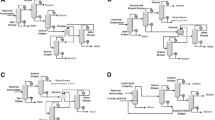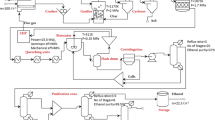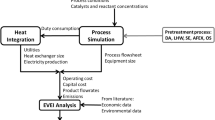Abstract
Currently, butanol obtained by fermentation is considered as potential biofuel. In this work, it has been simulated and optimized a process to produce acetone, butanol and ethanol by means of lignocellulosic material. To accomplish this task, initially, it was planned the raw material selection, followed by the simulation in MATLAB of simultaneous saccharification, fermentation and separation reactor (SFS) and finally, the stream coming from fermentation was purified. The separation stage was selected from three different options to purify that effluent. The entire process was evaluated under a robust optimization process considering environmental, economic and energetic objective functions by means of a hybrid stochastic method, differential evolution with tabu list. The obtained results showed that the best scheme to produce and purify butanol was the SFS-3C, which considers thermally coupled columns to purify acetone, butanol and ethanol. In general terms, it was obtained as result 0.138 $/kgbutanol, 0.132 points/kgbutanol and 66.8 regarding to the total annual cost, environmental impact and exergy efficiency, respectively.















Similar content being viewed by others
Abbreviations
- ABE:
-
Acetone–butanol–ethanol
- C TM :
-
Capital cost of the plant
- C ut :
-
Utility costs
- DDE:
-
Dynamic data exchange
- DE:
-
Differential evolution
- DETL:
-
Differential evolution with tabu list
- D cn :
-
Column diameter
- F ext :
-
Extractant flow
- F rn :
-
Distillate fluxes
- TAC:
-
Total annual cost
- LLE:
-
Liquid–liquid extraction
- LCA:
-
Life cycle assessment
- N tn :
-
Total column stages
- N fn :
-
Feed stages
- ROI:
-
Return of investment
- SFS:
-
Integrated reactor saccharification–fermentation with simultaneous recovery
- R rn :
-
Reflux ratio
- TAC:
-
Total annual cost
- TL:
-
Tabu list
- x m :
-
Vectors of required purities
- y m :
-
Vectors of obtained purities
- F :
-
Mass flow
- V :
-
Volume
- S :
-
Substrate
- x :
-
Molar fraction
- C :
-
Amount of mass in the reactor
- GEI99:
-
Global ecoindicator 99
- NEB:
-
Net energy balance
- η :
-
Exergy efficiency
- NPV:
-
Net present value
- IES:
-
Ideal energy efficiency of separation
- A :
-
Raw material
- X :
-
Amount of biomass used
- D :
-
Dilution rate
- ENZ:
-
Amount of enzyme
- N fni :
-
Feed stage
- F rni :
-
Flow of interconnection
- MODE-TL:
-
Multi-objetive differential evolution with tabu list
- R s :
-
Yield for butanol fermentation
- LHV:
-
Lower heating value of butanol
- H s :
-
Energy consumption for purification
- PUb :
-
Quantity of each raw material
- RMUb :
-
Unitary ecoindicator of raw material
- EI99PUR:
-
Ecoindicator of purification stage
- β b :
-
Amount of chemical released per unit of reference flow
- α b,k :
-
Damage caused in category
- ω d :
-
Weighting factor for damage in category
- δ d :
-
Normalization factor for damage
- EI99RM:
-
Ecoindicator 99 of total raw material used
- C GR :
-
Total grassroots costs
- \(C_{{{\text{BM}},i}}^{\text{}}\) :
-
Module cost of the equipment
- C BM, i :
-
Module cost of the equipment considers real operation
- C R :
-
Reactor cost
- C T :
-
Column cost
- C IN :
-
Condenser cost
- C IE :
-
Initial investment
- C E :
-
Electricity cost
- C V :
-
Steam cost
- C AE :
-
Cooling water cost
- C S :
-
Substrate cost
- C ENZ :
-
Enzyme cost
- C Ex :
-
Cost due to extractant lost
- NEB:
-
Net energy balance
- LHV:
-
Lower heating value
- IES:
-
Ideal energy efficiency of separation
- R s :
-
Yield ABE
- H s :
-
Energy consumption for purification
- NEt :
-
Net earnings value
- FTDCt :
-
Depreciable capital investment
- φ :
-
Net earnings after tax rate
- Revt :
-
Revenues
- FOCt :
-
Facility operating
- TOCt :
-
Transportation
- E x,ABE :
-
Exergy of produced ABE (MW)
- E x,biomass :
-
Exergy of biomass (MW)
- E x,heating :
-
Exergy of heating (MW)
- E x,reactor :
-
Exergy of reactor (MW)
References
Akinci B, Kassebaum PG, Fitch JV, Thompson RW (2008) The role of bio-fuels in satisfying US transportation fuel demands. Energy Policy 36:3485–3491. https://doi.org/10.1016/j.enpol.2008.05.021
Andrié P, Meyer AS, Jensen PA, Dam-Johansen K (2010) Reactor design for minimizing product inhibition during enzymatic lignocellulose hydrolysis. II. Quantification of inhibition and suitability of membrane reactors. Biotechnol Adv 28:407–425
Azapagic A, Clift R (1999) The application of life cycle assessment to process optimisation. Comput Chem Eng 23:1509–1526
Barton WE, Daugulis A (1992) Evaluation of solvents for extractive butanol fermentation with Clostridium acetobutylicum and the use of poly(propylene glycol) 1200. Appl Microbiol Biotechnol 36:632–639. https://doi.org/10.1007/BF00183241
Bechara R, Gomez A, Saint-Antonin V et al (2016) Methodology for the design and comparison of optimal production configurations of first and first and second generation ethanol with power. Appl Energy 184:247–265. https://doi.org/10.1016/j.apenergy.2016.09.100
Bhattacharya SS, Garlapati VK, Banerjee R (2011) Optimization of laccase production using response surface methodology coupled with differential evolution. New Biotechnol 28:31–39. https://doi.org/10.1016/j.nbt.2010.06.001
Bonilla-Petriciolet A, Rangaiah GP, Segovia-Hernández JG (2010) Evaluation of stochastic global optimization methods for modeling vapor–liquid equilibrium data. Fluid Phase Equilib 287:111–125. https://doi.org/10.1016/j.fluid.2009.09.021
Cooksley CM, Zhang Y, Wang H et al (2012) Targeted mutagenesis of the Clostridium acetobutylicum acetone–butanol–ethanol fermentation pathway. Metab Eng 14:630–641. https://doi.org/10.1016/j.ymben.2012.09.001
Díaz VHG, Tost GO (2016a) Butanol production from lignocellulose by simultaneous fermentation, saccharification, and pervaporation or vacuum evaporation. Bioresour Technol 218:174–182. https://doi.org/10.1016/j.biortech.2016.06.091
Díaz VHG, Tost GO (2016b) Ethanol and isobutanol dehydration by heat-integrated distillation. Chem Eng Process 108:117–124
Edgerton RH (1992) Available Energy and Environmental Economics. D.C. Heath, Toronto
Errico M, Sanchez-Ramirez E, Quiroz-Ramìrez JJ et al (2016) Synthesis and design of new hybrid configurations for biobutanol purification. Comput Chem Eng 84:482–492. https://doi.org/10.1016/j.compchemeng.2015.10.009
Gapes JR (2000) The economics of acetone-butanol fermentation: theoretical and market considerations. J Mol Microbiol Biotechnol 2:27–32
Gassner M, Marechal F (2013) Increasing efficiency of fuel ethanol production from lignocellulosic biomass by process integration. Energy Fuels 27:2017–2115
Gebreslassie BH, Guillén-Gosálbez G, Jiménez L, Boer D (2009) Design of environmentally conscious absorption cooling systems via multi-objective optimization and life cycle assessment. Appl Energy 86:1712–1722. https://doi.org/10.1016/j.apenergy.2008.11.019
Goedkoop M, Spriensma R (2000) The Eco-indicator 99 A damage oriented method for Life Cycle Impact Assessment Methodology Annex
Groot WJ, Soedjak HS, Donck PB et al (1990) Butanol recovery from fermentations by liquid–liquid extraction and membrane solvent extraction. Bioprocess Eng 5:203–216
Groot WJ, Van Der LansRGJM, Luyben KCAM (1992) Technologies for butanol recovery integrated with fermentations. Process Biochem 27:61–75
Guthrie KM (1969) Capital cost estimating, Chemical Engineering, March 24, p 114
Jang YS, Malaviya A, Cho C et al (2012) Butanol production from renewable biomass by clostridia. Bioresour Technol 123:653–663
Kadam KL, Rydholm EC, McMillan JD (2004) Development and validation of a kinetic model for enzymatic saccharification of lignocellulosic biomass. Biotechnol Prog 20:698–705. https://doi.org/10.1021/bp034316x
Kheawhom S (2010) Efficient constraint handling scheme for differential evolutionary algorithm in solving chemical engineering optimization problem. J Ind Eng Chem 16:620–628. https://doi.org/10.1016/j.jiec.2010.03.004
Kiss AA, Lange JP, Schuur B et al (2016) Separation technology-making a difference in biorefineries. Biomass Bioenerg 95:296–309. https://doi.org/10.1016/j.biombioe.2016.05.021
Kumar S, Datta D, Babu BV (2011) Estimation of equilibrium parameters using differential evolution in reactive extraction of propionic acid by tri-N-butyl phosphate. Chem Eng Process Process Intensif 50:614–622. https://doi.org/10.1016/j.cep.2011.03.004
Lenz TG, Morelra AR (1980) Economic evaluation of the acetone–butanol fermantation. Ind Eng Chem Prod Res Dev 19(4):478–483
López-Maldonado LA, Ponce-Ortega JM, Segovia-Hernández JG (2011) Multiobjective synthesis of heat exchanger networks minimizing the total annual cost and the environmental impact. Appl Therm Eng 31:1099–1113. https://doi.org/10.1016/j.applthermaleng.2010.12.005
Luyben WL, Chien IL (2011) Design and control of distillation systems for separating azeotropes. Wiley, New York
Maddox IS (1989) The acetone–butanol–ethanol fermentation: recent progress in technology. Biotechnol Genet Eng Rev 7:189–220. https://doi.org/10.1080/02648725.1989.10647859
Mariano AP, Qureshi N, Maciel Filho R, Ezeji TC (2012) Assessment of in situ butanol recovery by vacuum during acetone butanol ethanol (ABE) fermentation. J Chem Technol Biotechnol 87:334–340. https://doi.org/10.1002/jctb.2717
Miranda-Galindo EY, Segovia-Hernández JG, Hernández S, Bonilla-Petriciolet A (2014) Multiobjective optimization of a hydrodesulfurization process of diesel using distillation with side reactor. Ind Eng Chem Res 53:16425–16435. https://doi.org/10.1021/ie501940v
Niemistö J, Saavalainen P, Isomäki R, Kolli T, Huuhtanen M, Keiski RL (2013) Biobutanol production from biomass. In: Gupta VK, Tuohy MG (eds) Biofuel technologies: recent developments. Springer, New York, pp 443–470
Oudshoorn A, van der Wielen LAM, Straathof AJJ (2009) Assessment of options for selective 1-butanol recovery from aqueous solution. Ind Eng Chem Res 48:7325–7336. https://doi.org/10.1021/ie900537w
Parekh M, Blaschek HP (1999) Butanol production by hypersolvent-producing mutant Clostridium beijerinckii BA101 in corn steep water medium containing maltodextrin. Biotechnol Lett 21:45–48. https://doi.org/10.1023/A:1005406120874
Quiroz-Ramírez JJ, Sánchez-Ramírez E, Hernández S et al (2017) Multiobjective stochastic optimization approach applied to a hybrid process production-separation in the production of biobutanol. Ind Eng Chem Res 56:1823–1833. https://doi.org/10.1021/acs.iecr.6b04230
Qureshi N, Blaschek HP (2000) Economics of butanol fermentation using hyper-butanol producing Clostridium beijerinckii BA101. Food Bioprod Process 78:139–144. https://doi.org/10.1205/096030800532888
Qureshi N, Blaschek HP (2001) ABE production from corn: a recent economic evaluation. J Ind Microbiol Biotechnol 27:292–297. https://doi.org/10.1038/sj/jim/7000123
Qureshi N, Hughes S, Maddox IS, Cotta MA (2005) Energy-efficient recovery of butanol from model solutions and fermentation broth by adsorption. Bioprocess Biosyst Eng 27:215–222. https://doi.org/10.1007/s00449-005-0402-8
Qureshi N, Singh V, Liu S et al (2014) Process integration for simultaneous saccharification, fermentation, and recovery (SSFR): production of butanol from corn stover using Clostridium beijerinckii P260. Bioresour Technol 154:222–228. https://doi.org/10.1016/j.biortech.2013.11.080
Ranjan A, Moholkar VS (2009) Biobutanol: a Viable Gasoline Substitute through ABE Fermentation. Proc Int Conf Energy Environ 51:497–503
Rosen MA, Dincer I, Kanoglu M (2008) Role of exergy in increasing efficiency and sustainability and reducing environmental impact. Energy Policy 36:128–137. https://doi.org/10.1016/j.enpol.2007.09.006
Santibañez-Aguilar JE, González-Campos JB, Ponce-Ortega JM et al (2014) Optimal planning and site selection for distributed multiproduct biorefineries involving economic, environmental and social objectives. J Clean Prod 65:270–294. https://doi.org/10.1016/j.jclepro.2013.08.004
Seader JD, Ernest JH, Roper DK (2011) Separation process principles-chemical and biochemical operations. Chemical and Biochemical Operations. Wiley, Hoboken, NJ
Sharma S, Rangaiah GP (2010) Separation process principles-chemical and biochemical operations, pp 978–981
Sharma S, Rangaiah GP (2013) An improved multi-objective differential evolution with a termination criterion for optimizing chemical processes. Comput Chem Eng 56:155–173. https://doi.org/10.1016/j.compchemeng.2013.05.004
Shinto H, Tashiro Y, Yamashita M et al (2007) Kinetic modeling and sensitivity analysis of acetone–butanol–ethanol production. J Biotechnol 131:45–56. https://doi.org/10.1016/j.jbiotec.2007.05.005
Shinto H, Tashiro Y, Kobayashi G et al (2008) Kinetic study of substrate dependency for higher butanol production in acetone–butanol–ethanol fermentation. Process Biochem 43:1452–1461
Srinivas M, Rangaiah GP (2007) Differential Evolution with Tabu List for solving nonlinear and mixed-integer nonlinear programming problems. Ind Eng Chem Res 46:7126–7135
Szargut J, Morris DR, Steward FR (1988) Exergy analysis of thermal, chemical, and metallurgical processes. Springer
Tashiro Y, Sonomoto K (2010) Advances in butanol production by clostridia. Curr Res Technol Educ Top Appl Microbiol Microbial Biotechnol 2:1383–1394
Tijmensen MJA, Faaij APC, Hamelinck CN, Van Hardeveld MRM (2002) Exploration of the possibilities for production of Fischer Tropsch liquids and power via biomass gasification. Biomass Bioenerg 23:129–152. https://doi.org/10.1016/S0961-9534(02)00037-5
Turton R, Whiting B, Bailie CR et al (2012) Analysis, synthesis, and design of chemical processes, 4th ed
Ulrich GD (1984) A guide to chemical engineering process design and economics. Wiley, New York, p 295
Vakili R, Setoodeh P, Pourazadi E et al (2011) Utilizing differential evolution (DE) technique to optimize operating conditions of an integrated thermally coupled direct DME synthesis reactor. Chem Eng J 168:321–332. https://doi.org/10.1016/j.cej.2011.01.032
Van der Merwe AB, Cheng H, Görgens JF, Knoetze JH (2013) Comparison of energy efficiency and economics of process designs for biobutanol production from sugarcane molasses. Fuel 105:451–458. https://doi.org/10.1016/j.fuel.2012.06.058
Vázquez-Castillo JA, Segovia-Hernández JG, Ponce-Ortega JM (2015) Multiobjective optimization approach for integrating design and control in multicomponent distillation sequences. Ind Eng Chem Res 54:12320–12330. https://doi.org/10.1021/acs.iecr.5b01611
Wooley RJ, Putsche V (1996) Development of an ASPEN PLUS physical property database for biofuels components
Wu M, Wang M, Liu J, Huo H (2008) Assessment of potential life-cycle energy and greenhouse gas emission effects from using corn-based butanol as a transportation fuel. Biotechnol Prog 24(6):1204–1214
Xue C, Zhao X-Q, Liu C-G et al (2013) Prospective and development of butanol as an advanced biofuel. Biotechnol Adv 31:1575–1584. https://doi.org/10.1016/j.biotechadv.2013.08.004
Xue C, Zhao J, Chen L (2014) Integrated butanol recovery for an advanced biofuel: current state and prospects. Appl Microbiol Biotechnol 98:3463–3474. https://doi.org/10.1007/s00253-014-5561-6
Yerramsetty KM, Murty CVS (2008) Synthesis of cost-optimal heat exchanger networks using differential evolution. Comput Chem Eng 32:1861–1876. https://doi.org/10.1016/j.compchemeng.2007.10.005
Acknowledgements
The financial support provided by the Universidad de Guanajuato and CONACyT (México) is gratefully acknowledged.
Author information
Authors and Affiliations
Corresponding author
Rights and permissions
About this article
Cite this article
Quiroz-Ramírez, J.J., Sánchez-Ramírez, E. & Segovia-Hernández, J.G. Energy, exergy and techno-economic analysis for biobutanol production: a multi-objective optimization approach based on economic and environmental criteria. Clean Techn Environ Policy 20, 1663–1684 (2018). https://doi.org/10.1007/s10098-018-1486-6
Received:
Accepted:
Published:
Issue Date:
DOI: https://doi.org/10.1007/s10098-018-1486-6




